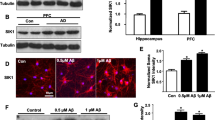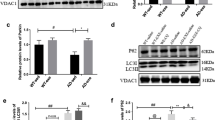Abstract
Rationale
Alzheimer’s disease (AD) is characterized by memory loss and synaptic damage. Previous studies suggested that xanthoceraside decreases glutamate-induced PC12 cell death, ameliorates memory deficits, and increases the number of dendritic spines in AD mice. These results indicated that xanthoceraside might have activities that protect synaptic plasticity. Herein, we detected the effect of xanthoceraside on synaptic function.
Materials and methods
Three-month-old APP/PS1 transgenic mice were orally treated with xanthoceraside (0.02, 0.08, or 0.32 mg/kg) once daily for 4 months and then behavioral tests were performed. LTP and Fluo-4/AM were carried out in vivo and in vitro, respectively. CaMKII-GluR1 and NR2B-associated proteins on synapses were measured.
Results
Xanthoceraside administration alleviated learning-memory deficits and increased the LTP in APP/PS1 transgenic mice. Meanwhile, xanthoceraside increased the expression of pT286-CaMKII in synaptic and extrasynaptic pools and CaMKII, pS831-GluR1, and GluR1 in synaptic pools. In addition, xanthoceraside increased the total pY1472-NR2B and NR2B expression and increased the levels of pY1472-NR2B in synaptic and extrasynaptic pools and NR2B in synaptic pools. However, NR2B was decreased in extrasynaptic pools, which might be associated with decreased expression of STEP61 and pY531-Fyn. In vitro studies showed that xanthoceraside inhibited intracellular calcium overload and increased the number of and extended the length of dendrites in primary hippocampal neurons compared with the Aβ25–35 group.
Conclusions
The mechanism of xanthoceraside on ameliorating learning-memory deficits might be related to decrease intracellular calcium overload, increase CaMKII-GluR1 proteins, and up-regulate trafficking of pY1472-NR2B at synapse, thereby improving LTP in APP/PS1 transgenic mice.








Similar content being viewed by others
References
Arendt T (2009) Synaptic degeneration in Alzheimer's disease. Acta Neuropathol 118:167–179
Barria A, Malinow R (2005) NMDA receptor subunit composition controls synaptic plasticity by regulating binding to CaMKII. Neuron 48:289–301
Bayer KU, De Koninck P, Leonard AS, Hell JW, Schulman H (2001) Interaction with the NMDA receptor locks CaMKII in an active conformation. Nature 411:801–805
Bergstrom P et al (2016) Amyloid precursor protein expression and processing are differentially regulated during cortical neuron differentiation. Sci Rep 6:29200
Cao X, Wang H, Mei B, An S, Yin L, Wang LP, Tsien JZ (2008) Inducible and selective erasure of memories in the mouse brain via chemical-genetic manipulation. Neuron 60:353–366
Chen QS, Kagan BL, Hirakura Y, Xie CW (2000) Impairment of hippocampal long-term potentiation by Alzheimer amyloid beta-peptides. J Neurosci Res 60:65–72
Chi TY, Wang LH, Ji XF, Shen L, Zou LB (2013) Protective effect of xanthoceraside against beta-amyloid-induced neurotoxicity in neuroblastoma SH-SY5Y cells. J Asian Nat Prod Res 15:1013–1022
Deacon RM (2006) Assessing nest building in mice. Nat Protoc 1:1117–1119
Duan ZZ et al (2016) Protease activated receptor 1 (PAR1) enhances Src-mediated tyrosine phosphorylation of NMDA receptor in intracerebral hemorrhage (ICH). Sci Rep 6:29246
Filali M, Lalonde R (2009) Age-related cognitive decline and nesting behavior in an APPswe/PS1 bigenic model of Alzheimer’s disease. Brain Res 1292:93–99
Gladding CM, Raymond LA (2011) Mechanisms underlying NMDA receptor synaptic/extrasynaptic distribution and function. Mol Cell Neurosci 48:308–320
Goebel-Goody SM, Davies KD, Alvestad Linger RM, Freund RK, Browning MD (2009) Phospho-regulation of synaptic and extrasynaptic N-methyl-d-aspartate receptors in adult hippocampal slices. Neuroscience 158:1446–1459
Groc L, Bard L, Choquet D (2009) Surface trafficking of N-methyl-D-aspartate receptors: physiological and pathological perspectives. Neuroscience 158:4–18
Gu Z, Liu W, Yan Z (2009) {Beta}-amyloid impairs AMPA receptor trafficking and function by reducing Ca2+/calmodulin-dependent protein kinase II synaptic distribution. J Biol Chem 284:10639–10649
Hicklin TR et al (2011) Alcohol inhibition of the NMDA receptor function, long-term potentiation, and fear learning requires striatal-enriched protein tyrosine phosphatase. Proc Natl Acad Sci U S A 108:6650–6655
Ivanov A, Pellegrino C, Rama S, Dumalska I, Salyha Y, Ben-Ari Y, Medina I (2006) Opposing role of synaptic and extrasynaptic NMDA receptors in regulation of the extracellular signal-regulated kinases (ERK) activity in cultured rat hippocampal neurons. J Physiol 572:789–798
Jin G et al (2014) Xanthoceraside rescues learning and memory deficits through attenuating beta-amyloid deposition and tau hyperphosphorylation in APP mice. Neurosci Lett 573:58–63
Jo J et al (2011) Abeta(1-42) inhibition of LTP is mediated by a signaling pathway involving caspase-3, Akt1 and GSK-3beta. Nat Neurosci 14:545–547
Karasawa T, Lombroso PJ (2014) Disruption of striatal-enriched protein tyrosine phosphatase (STEP) function in neuropsychiatric disorders. Neurosci Res 89:1–9
Kelly PT, McGuinness TL, Greengard P (1984) Evidence that the major postsynaptic density protein is a component of a Ca2+/calmodulin-dependent protein kinase. Proc Natl Acad Sci U S A 81:945–949
Kurup P et al (2010) Abeta-mediated NMDA receptor endocytosis in Alzheimer's disease involves ubiquitination of the tyrosine phosphatase STEP61. J Neurosci 30:5948–5957
Lau CG, Zukin RS (2007) NMDA receptor trafficking in synaptic plasticity and neuropsychiatric disorders. Nat Rev Neurosci 8:413–426
Lee AY, Hwang BR, Lee MH, Lee S, Cho EJ (2016a) Perilla frutescens var. japonica and rosmarinic acid improve amyloid-beta25–35 induced impairment of cognition and memory function. Nutr Res Pract 10:274–281
Lee HK, Barbarosie M, Kameyama K, Bear MF, Huganir RL (2000) Regulation of distinct AMPA receptor phosphorylation sites during bidirectional synaptic plasticity. Nature 405:955–959
Lee K et al (2016b) Replenishment of microRNA-188-5p restores the synaptic and cognitive deficits in 5XFAD mouse model of Alzheimer's disease. Sci Rep 6:34433
Li PP, Wang WP, Liu ZH, Xu SF, Lu WW, Wang L, Wang XL (2014) Potassium 2-(1-hydroxypentyl)-benzoate promotes long-term potentiation in Abeta1-42-injected rats and APP/PS1 transgenic mice. Acta Pharmacol Sin 35:869–878
Li Y et al (2016) Xanthoceras Sorbifolia extracts ameliorate dendritic spine deficiency and cognitive decline via upregulation of BDNF expression in a rat model of Alzheimer's disease. Neurosci Lett 629:208–214
Lisman J, Schulman H, Cline H (2002) The molecular basis of CaMKII function in synaptic and behavioural memory. Nat Rev Neurosci 3:175–190
Liu SB, Zhao MG (2013) Neuroprotective effect of estrogen: role of nonsynaptic NR2B-containing NMDA receptors. Brain Res Bull 93:27–31
Liu Z, Zang Y, Qiao L, Liu K, Ouyang Y, Zhang Y, Chen D (2016) ASPP2 involvement in p53-mediated HIV-1 envelope glycoprotein gp120 neurotoxicity in mice cerebrocortical neurons. Sci Rep 6:33378
Lu P et al (2012) Xanthoceraside attenuates amyloid beta peptide(2)(5)(-)(3)(5)-induced learning and memory impairments in mice. Psychopharmacology 219:181–190
Makhaeva GF et al (2015) Conjugates of gamma-carbolines and phenothiazine as new selective inhibitors of butyrylcholinesterase and blockers of NMDA receptors for Alzheimer disease. Sci Rep 5:13164
Malenka RC, Bear MF (2004) LTP and LTD: an embarrassment of riches. Neuron 44:5–21
Mori H, Mishina M (1995) Structure and function of the NMDA receptor channel. Neuropharmacology 34:1219–1237
Morris RG, Garrud P, Rawlins JN, O'Keefe J (1982) Place navigation impaired in rats with hippocampal lesions. Nature 297:681–683
Nakazawa T et al (2001) Characterization of Fyn-mediated tyrosine phosphorylation sites on GluR epsilon 2 (NR2B) subunit of the N-methyl-D-aspartate receptor. J Biol Chem 276:693–699
Nicholson E, Kullmann DM (2017) T-type calcium channels contribute to NMDA receptor-independent synaptic plasticity in hippocampal regular-spiking oriens-alveus interneurons. J Physiol 595(11):3449–3458
Olsen KM, Sheng M (2012) NMDA receptors and BAX are essential for Abeta impairment of LTP. Sci Rep 2:225
Pick JE, Malumbres M, Klann E (2013) The E3 ligase APC/C-Cdh1 is required for associative fear memory and long-term potentiation in the amygdala of adult mice. Learn Mem 20:11–20
Popugaeva E, Vlasova OL, Bezprozvanny I (2015) Restoring calcium homeostasis to treat Alzheimer's disease: a future perspective. Neurodegener Dis Manag 5:395–398
Prybylowski K, Chang K, Sans N, Kan L, Vicini S, Wenthold RJ (2005) The synaptic localization of NR2B-containing NMDA receptors is controlled by interactions with PDZ proteins and AP-2. Neuron 47:845–857. https://doi.org/10.1016/j.neuron.2005.08.016
Shankar GM, Bloodgood BL, Townsend M, Walsh DM, Selkoe DJ, Sabatini BL (2007) Natural oligomers of the Alzheimer amyloid-beta protein induce reversible synapse loss by modulating an NMDA-type glutamate receptor-dependent signaling pathway. J Neurosci 27:2866–2875
Snyder EM et al (2005) Regulation of NMDA receptor trafficking by amyloid-beta. Nat Neurosci 8:1051–1058
Talantova M et al (2013) Abeta induces astrocytic glutamate release, extrasynaptic NMDA receptor activation, and synaptic loss. Proc Natl Acad Sci U S A 110:E2518–E2527
Tian M, Xu J, Lei G, Lombroso PJ, Jackson MF, MacDonald JF (2016) STEP activation by Galphaq coupled GPCRs opposes Src regulation of NMDA receptors containing the GluN2A subunit. Sci Rep 6:36684
Van den Oever MC, Spijker S, Smit AB (2012) The synaptic pathology of drug addiction. Adv Exp Med Biol 970:469–491
Walsh DM et al (2002) Naturally secreted oligomers of amyloid beta protein potently inhibit hippocampal long-term potentiation in vivo. Nature 416:535–539
Wang Y, Mattson MP (2014) L-type Ca2+ currents at CA1 synapses, but not CA3 or dentate granule neuron synapses, are increased in 3xTgAD mice in an age-dependent manner. Neurobiol Aging 35:88–95
Wei W, Nguyen LN, Kessels HW, Hagiwara H, Sisodia S, Malinow R (2010) Amyloid beta from axons and dendrites reduces local spine number and plasticity. Nat Neurosci 13:190–196
Xu J, Kurup P, Foscue E, Lombroso PJ (2015) Striatal-enriched protein tyrosine phosphatase regulates the PTPalpha/Fyn signaling pathway. J Neurochem 134:629–641
Xu J, Kurup P, Nairn AC, Lombroso PJ (2012) Striatal-enriched protein tyrosine phosphatase in Alzheimer's disease. Adv Pharmacol 64:303–325
Zhang Y et al (2010) Genetic reduction of striatal-enriched tyrosine phosphatase (STEP) reverses cognitive and cellular deficits in an Alzheimer's disease mouse model. Proc Natl Acad Sci U S A 107:19014–19019
Zhang Y, Li P, Feng J, Wu M (2016a) Dysfunction of NMDA receptors in Alzheimer's disease. Neurol Sci 37:1039–1047
Zhang Y, Liu C, Wang J, Li Q, Ping H, Gao S, Wang P (2016b) MiR-299-5p regulates apoptosis through autophagy in neurons and ameliorates cognitive capacity in APPswe/PS1dE9 mice. Sci Rep 6:24566
Zhao D, Watson JB, Xie CW (2004) Amyloid beta prevents activation of calcium/calmodulin-dependent protein kinase II and AMPA receptor phosphorylation during hippocampal long-term potentiation. J Neurophysiol 92:2853–2858
Zheng X et al (2014) Methyllycaconitine alleviates amyloid-beta peptides-induced cytotoxicity in SH-SY5Y cells. PLoS One 9:e111536
Zhu L et al. (2017) Xanthoceraside modulates neurogenesis to ameliorate cognitive impairment in APP/PS1 transgenic mice J Physiol Sci
Zhu L et al (2015) A novel phosphodiesterase-5 Inhibitor: Yonkenafil modulates neurogenesis, gliosis to improve cognitive function and ameliorates amyloid burden in an APP/PS1 transgenic mice model. Mech Ageing Dev 150:34–45
Acknowledgements
This study was supported by the Research Fund for National Natural Science Foundation of China (No. 81373992) and the Joint Founds of NSFC-Liaoning (U1508220).
Author information
Authors and Affiliations
Contributions
L. Zhu conceived the experiments, contributed to research data, and drafted the manuscript; X. Ji, T. Chi, and P. Liu revised the manuscript. X. Zhao, L. Yang, and D. Liu contributed to technical assistance. X. Guo contributed to raise animals. L. Zou revised the manuscript and supervised the analysis.
Corresponding author
Ethics declarations
Conflict of interest
The authors declare that they have no conflict of interest.
Electronic supplementary material
ESM 1
(RAR 194091 kb)
Rights and permissions
About this article
Cite this article
Zhu, L., Yang, L., Zhao, X. et al. Xanthoceraside modulates NR2B-containing NMDA receptors at synapses and rescues learning-memory deficits in APP/PS1 transgenic mice. Psychopharmacology 235, 337–349 (2018). https://doi.org/10.1007/s00213-017-4775-6
Received:
Accepted:
Published:
Issue Date:
DOI: https://doi.org/10.1007/s00213-017-4775-6




